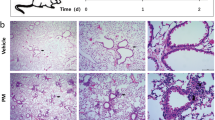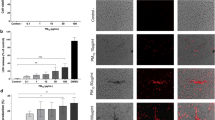Abstract
Human exposure to PM2.5 (particulate matter with an aerodynamic diameter below 2.5 μm) is known to be responsible for airway inflammation and may also induce airway remodelling. In respiratory epithelial cells exposed to PM2.5, releases of pro-inflammatory cytokines such as granulocyte macrophage-colony stimulating factor (GM-CSF) and growth factor ligands of the epidermal growth factor receptor (EGFR) are increased. The present study aimed at determining the involvement of EGFR ligands by autocrine effects in PM2.5-induced GM-CSF release. PM2.5 exposure triggers GM-CSF release by human bronchial epithelial (HBE) cells. This release is dependent on EGFR activation by ligand binding as it is inhibited by AG1478, an inhibitor of EGFR tyrosine kinase activity as well as by a neutralizing anti-EGFR antibody. The use of conditioned medium from cells previously exposed to PM2.5 demonstrates that PM2.5-exposed cells release soluble EGFR ligands able to induce GM-CSF release by an autocrine manner. It was further demonstrated by inhibiting tumour-necrosis factor-alpha converting enzyme (TACE) that is involved in some EGFR ligand shedding. TAPI-2 and GM-6001, two TACE inhibitors, prevented the PM2.5-induced GM-CSF release as well as the silencing of TACE by siRNA. We provide evidence that the pro-inflammatory response induced by PM2.5 exposure on HBE cells, results from an autocrine effect of EGFR ligands released by TACE activity. This autocrine loop by eliciting and sustaining inflammation could contribute to exacerbation of airway remodelling in respiratory-compromised individuals.





Similar content being viewed by others
References
Baginski TK, Dabbagh K, Satjawatcharaphong C, Swinney DC (2006) Cigarette smoke synergistically enhances respiratory mucin induction by proinflammatory stimuli. Am J Respir Cell Mol Biol 35:165–174
Baulig A, Garlatti M, Bonvallot V, Marchand A, Barouki R, Marano F, Baeza-Squiban A (2003) Involvement of reactive oxygen species in the metabolic pathways triggered by diesel exhaust particles in human airway epithelial cells. Am J Physiol Lung Cell Mol Physiol 285:L671–L679
Baulig A, Poirault J, Ausset P, Schins R, Shi T, Baralle D, Dorlhene P, Meyer M, Lefevre R, Baeza-Squiban A, Marano F (2004) Physicochemical characteristics and biological activities of seasonal atmospheric particulate matter sampling in two locations of Paris. Environ Sci Technol 38:5985–5992
Baulig A, Blanchet S, Rumelhard M, Lacroix G, Marano F, Baeza-Squiban A (2007) Fine urban atmospheric particulate matter modulates inflammatory gene and protein expression in human bronchial epithelial cells. Front Biosci 12:771–782
Bayram H, Devalia JL, Sapsford RJ, Ohtoshi T, Miyabara Y, Sagai M, Davies RJ (1998) The effect of diesel exhaust particles on cell function and release of inflammatory mediators from human bronchial epithelial cells in vitro. Am J Respir Cell Mol Biol 18:441–448
Behndig AF, Mudway IS, Brown JL, Stenfors N, Helleday R, Duggan ST, Wilson SJ, Boman C, Cassee FR, Frew AJ, Kelly FJ, Sandström T, Blomberg A (2006) Airway antioxidant and inflammatory responses to diesel exhaust exposure in healthy humans. Eur Respir J 27:359–365
Blanchet S, Ramgolam K, Baulig A, Marano F, Baeza-Squiban A (2004) Fine particulate matter induces amphiregulin secretion by bronchial epithelial cells. Am J Respir Cell Mol Biol 30:421–427
Boland S, Bonvallot V, Fournier T, Baeza-Squiban A, Aubier M, Marano F (2000) Mechanisms of GM-CSF increase by diesel exhaust particles in human airway epithelial cells. Am J Physiol Lung Cell Mol Physiol 278:L25–L32
Bonner JC (2002) The epidermal growth factor receptor at the crossroads of airway remodeling. Am J Physiol Lung Cell Mol Physiol 283:L528–L530
Brunekreef B, Beelen R, Hoek G, Schouten L, Bausch-Goldbohm S, Fischer P, Armstrong B, Hughes E, Jerrett M, van den Brandt P (2009) Effects of long-term exposure to traffic-related air pollution on respiratory and cardiovascular mortality in the Netherlands: the NLCS-AIR study. Res Rep Health Eff Inst 139:5–71; (discussion 73–89)
Burgel PR, Nadel JA (2008) Epidermal growth factor receptor-mediated innate immune responses and their roles in airway diseases. Eur Respir J 32:1068–1081
Casalino-Matsuda SM, Monzón ME, Forteza RM (2006) Epidermal growth factor receptor activation by epidermal growth factor mediates oxidant-induced goblet cell metaplasia in human airway epithelium. Am J Respir Cell Mol Biol 34:581–591
Chokki M, Mitsuhashi H, Kamimura T (2006) Metalloprotease-dependent amphiregulin release mediates tumor necrosis factor-alpha-induced IL-8 secretion in the human airway epithelial cell line NCI-H292. Life Sci 78:3051–3057
Churg A, Brauer M, del Carmen Avila-Casado M, Fortoul TI, Wright JL (2003) Chronic exposure to high levels of particulate air pollution and small airway remodeling. Environ Health Perspect 111:714–718
Cozens AL, Yezzi MJ, Kunzelmann K, Ohrui T, Chin L, Eng K, Finkbeiner WE, Widdicombe JH, Gruenert DC (1994) CFTR expression and chloride secretion in polarized immortal human bronchial epithelial cells. Am J Respir Cell Mol Biol 10:38–47
de Boer WI, Hau CM, van Schadewijk A, Stolk J, van Krieken JH, Hiemstra PS (2006) Expression of epidermal growth factors and their receptors in the bronchial epithelium of subjects with chronic obstructive pulmonary disease. Am J Clin Pathol 125:184–192
Dominici F, Peng RD, Bell ML, Pham L, McDermott A, Zeger SL, Samet JM (2006) Fine particulate air pollution and hospital admission for cardiovascular and respiratory diseases. JAMA 295:1127–1134
Enomoto Y, Orihara K, Takamasu T, Matsuda A, Gon Y, Saito H, Ra C, Okayama Y (2009) Tissue remodeling induced by hypersecreted epidermal growth factor and amphiregulin in the airway after an acute asthma attack. J Allergy Clin Immunol 124:913–920 (e911–e917)
Ghio AJ, Huang YC (2004) Exposure to concentrated ambient particles (CAPs): a review. Inhal Toxicol 16:53–59
Halonen JI, Lanki T, Yli-Tuomi T, Kulmala M, Tiittanen P, Pekkanen J (2008) Urban air pollution, and asthma and COPD hospital emergency room visits. Thorax 63:635–641
Hamilton LM, Torres-Lozano C, Puddicombe SM, Richter A, Kimber I, Dearman RJ, Vrugt B, Aalbers R, Holgate ST, Djukanović R, Wilson SJ, Davies DE (2003) The role of the epidermal growth factor receptor in sustaining neutrophil inflammation in severe asthma. Clin Exp Allergy 33:233–240
Holgate ST (2007) Epithelium dysfunction in asthma. J Allergy Clin Immunol 120:1233–1244 (quiz 1245–1236)
Jeffery PK (2004) Remodeling and inflammation of bronchi in asthma and chronic obstructive pulmonary disease. Proc Am Thorac Soc 1:176–183
Kido T, Tamagawa E, Bai N, Suda K, Yang HH, Li Y, Chiang G, Yatera K, Mukae H, Sin DD, Van Eeden SF (2011) Particulate matter induces translocation of IL-6 from the lung to the systemic circulation. Am J Respir Cell Mol Biol 44:197–204
Knol AB, de Hartog JJ, Boogaard H, Slottje P, van der Sluijs JP, Lebret E, Cassee FR, Wardekker JA, Ayres JG, Borm PJ, Brunekreef B, Donaldson K, Forastiere F, Holgate ST, Kreyling WG, Nemery B, Pekkanen J, Stone V, Wichmann HE, Hoek G (2009) Expert elicitation on ultrafine particles: likelihood of health effects and causal pathways. Part Fibre Toxicol 6:19
Le Cras TD, Acciani TH, Mushaben EM, Kramer EL, Pastura PA, Hardie WD, Korfhagen TR, Sivaprasad U, Ericksen M, Gibson AM, Holtzman MJ, Whitsett JA, Khurana Hershey GK (2011) Epithelial EGF receptor signaling mediates airway hyperreactivity and remodeling in a mouse model of chronic asthma. Am J Physiol Lung Cell Mol Physiol 300:L414–L421
Lee DC, Sunnarborg SW, Hinkle CL, Myers TJ, Stevenson MY, Russell WE, Castner BJ, Gerhart MJ, Paxton RJ, Black RA, Chang A, Jackson LF (2003) TACE/ADAM17 processing of EGFR ligands indicates a role as a physiological convertase. Ann NY Acad Sci 995:22–38
Lemjabbar-Alaoui H, Sidhu SS, Mengistab A, Gallup M, Basbaum C (2011) TACE/ADAM-17 phosphorylation by PKC-epsilon mediates premalignant changes in tobacco smoke-exposed lung cells. PLoS ONE 6:e17489
Li N, Hao M, Phalen RF, Hinds WC, Nel AE (2003) Particulate air pollutants and asthma. A paradigm for the role of oxidative stress in PM-induced adverse health effects. Clin Immunol 109:250–265
Mitschik S, Schierl R, Nowak D, Jörres RA (2008) Effects of particulate matter on cytokine production in vitro: a comparative analysis of published studies. Inhal Toxicol 20:399–414
Oberdörster G, Oberdörster E, Oberdörster J (2005) Nanotoxicology: an emerging discipline evolving from studies of ultrafine particles. Environ Health Perspect 113:823–839
Okumura S, Sagara H, Fukuda T, Saito H, Okayama Y (2005) FcepsilonRI-mediated amphiregulin production by human mast cells increases mucin gene expression in epithelial cells. J Allergy Clin Immunol 115:272–279
Peng RD, Bell ML, Geyh AS, McDermott A, Zeger SL, Samet JM, Dominici F (2009) Emergency admissions for cardiovascular and respiratory diseases and the chemical composition of fine particle air pollution. Environ Health Perspect 117:957–963
Ramgolam K, Favez O, Cachier H, Gaudichet A, Marano F, Martinon L, Baeza-Squiban A (2009) Size-partitioning of an urban aerosol to identify particle determinants involved in the proinflammatory response induced in airway epithelial cells. Part Fibre Toxicol 6:10
Reibman J, Hsu Y, Chen LC, Kumar A, Su WC, Choy W, Talbot A, Gordon T (2002) Size fractions of ambient particulate matter induce granulocyte macrophage colony-stimulating factor in human bronchial epithelial cells by mitogen-activated protein kinase pathways. Am J Respir Cell Mol Biol 27:455–462
Richter A, O’Donnell RA, Powell RM, Sanders MW, Holgate ST, Djukanović R, Davies DE (2002) Autocrine ligands for the epidermal growth factor receptor mediate interleukin-8 release from bronchial epithelial cells in response to cigarette smoke. Am J Respir Cell Mol Biol 27:85–90
Ritz SA, Stämpfli MR, Davies DE, Holgate ST, Jordana M (2002) On the generation of allergic airway diseases: from GM-CSF to Kyoto. Trends Immunol 23:396–402
Rumelhard M, Ramgolam K, Hamel R, Marano F, Baeza-Squiban A (2007) Expression and role of EGFR ligands induced in airway cells by PM2.5 and its components. Eur Respir J 30:1064–1073
Sacks JD, Stanek LW, Luben TJ, Johns DO, Buckley BJ, Brown JS, Ross M (2010) Particulate matter induced health effects: who’s susceptible? Environ Health Perspect 119(4):446–454
Shao MX, Nadel JA (2005) Dual oxidase 1-dependent MUC5AC mucin expression in cultured human airway epithelial cells. Proc Natl Acad Sci USA 102:767–772
Shim JY, Park SW, Kim DS, Shim JW, Jung HL, Park MS (2008) The effect of interleukin-4 and amphiregulin on the proliferation of human airway smooth muscle cells and cytokine release. J Korean Med Sci 23:857–863
Takano H, Ichinose T, Miyabara Y, Shibuya T, Lim HB, Yoshikawa T, Sagai M (1998) Inhalation of diesel exhaust enhances allergen-related eosinophil recruitment and airway hyperresponsiveness in mice. Toxicol Appl Pharmacol 150:328–337
Tao F, Gonzalez-Flecha B, Kobzik L (2003) Reactive oxygen species in pulmonary inflammation by ambient particulates. Free Radic Biol Med 35:327–340
Tsao MS, Zhu H, Viallet J (1996) Autocrine growth loop of the epidermal growth factor receptor in normal and immortalized human bronchial epithelial cells. Exp Cell Res 223:268–273
Valavanidis A, Fiotakis K, Bakeas E, Vlahogianni T (2005) Electron paramagnetic resonance study of the generation of reactive oxygen species catalysed by transition metals and quinoid redox cycling by inhalable ambient particulate matter. Redox Rep 10:37–51
Vlahos R, Bozinovski S, Hamilton JA, Anderson GP (2006) Therapeutic potential of treating chronic obstructive pulmonary disease (COPD) by neutralising granulocyte macrophage-colony stimulating factor (GM-CSF). Pharmacol Ther 112:106–115
Wang SW, Oh CK, Cho SH, Hu G, Martin R, Demissie-Sanders S, Li K, Moyle M, Yao Z (2005) Amphiregulin expression in human mast cells and its effect on the primary human lung fibroblasts. J Allergy Clin Immunol 115:287–294
Acknowledgments
The authors thank Annie Jaeger for her excellent technical help in cell culture (RMCX). This work was founded by grants from ADEME-Primequal (no. 0462C0056), Legs Poix, the Caisse d’Assurance Maladie des Professions Libérales de Province (Paris, France). K.R. was funded by ADEME and M.R. by the “ABIES” PhD programme for their PhD grants.
Conflict of interest
The authors declare that they have no conflict of interest.
Author information
Authors and Affiliations
Corresponding author
Rights and permissions
About this article
Cite this article
Ramgolam, K., Hamel, R., Rumelhard, M. et al. Autocrine effect of EGFR ligands on the pro-inflammatory response induced by PM2.5 exposure in human bronchial epithelial cells. Arch Toxicol 86, 1537–1546 (2012). https://doi.org/10.1007/s00204-012-0863-x
Received:
Accepted:
Published:
Issue Date:
DOI: https://doi.org/10.1007/s00204-012-0863-x




